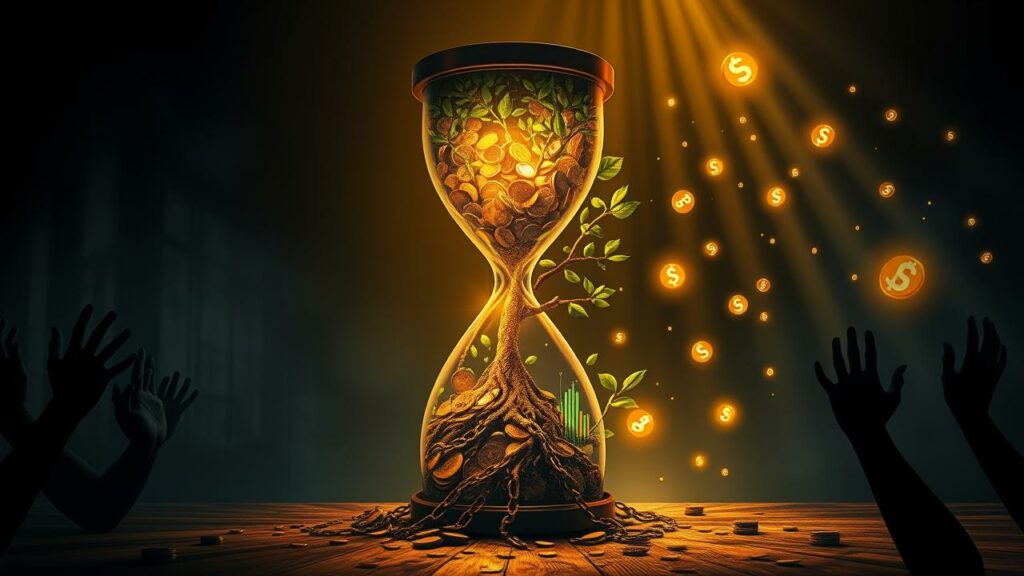Introduction: The Persistent Ache of “Not Enough”
That phantom ache in your chest, the one that arrives uninvited when you scroll past someone else’s sun-drenched vacation or a colleague’s promotion. It’s the quiet hiss of “not enough” that slithers into your thoughts as you pay the bills, a chilling soundtrack to the daily grind. This isn’t just stress; it’s the insidious grip of scarcity thinking, a mental cage built from fear, comparison, and the relentless whisper that you’re falling behind. But what if that cage has a key? What if learning how to reframe scarcity thinking isn’t about pretending problems don’t exist, but about forging a new lens through which to see your power, your resources, and your life?
This isn’t about platitudes or painting a smiley face on genuine struggle. It’s about digging deep into the primal wiring that makes us hoard, fear, and fixate on what’s missing, and then, with grit and insight, rewriting that code. Prepare to confront the shadows, because only by staring them down can you reclaim the light.
The Core Code: Unlocking Abundance Now
Tired of the internal monologue that sounds suspiciously like a broke doomsayer? Here’s the stark truth: scarcity is a mindset, not an immutable reality. We’ll dissect why your brain clings to “not enough” like a lifeline (spoiler: it thinks it’s helping). You’ll learn to spot its sneaky manifestations in your everyday anxieties and decisions. Then, we get to the good part: concrete, no-fluff strategies to rewire that thinking, finding power even in constraints, and finally, transforming your relationship with everything from your time to your finances. This is your blueprint for breaking free.
The Ghost in the Machine: Why Your Brain Craves ‘Not Enough’
Ever wonder why, even when things are objectively okay, a part of you is stockpiling canned goods for an apocalypse that’s probably just a Tuesday? That, my friend, is your “scarcity brain” at work. It’s an ancient alarm system, calibrated for a world where the next meal or a safe place to sleep wasn’t a guarantee. A hangover from our cave-dwelling days, this primal programming is fantastic if you’re actually facing a sabre-toothed tiger. Less so when it’s triggered by your neighbour’s new SUV or a dip in your crypto—because, evolutionarily speaking, your brain can’t always tell the difference between a genuine threat and a perceived one.
This old wiring gets triggered by modern “scarcity cues”—those insidious little nudges from social media, advertising, even well-meaning (or not-so-well-meaning) relatives, all screaming that you lack something vital. The result? A persistent, low-grade hum of anxiety, a craving for more that often doesn’t even have a name, just a hollow ache. Understanding this isn’t about making excuses; it’s about recognizing the enemy within the gates so you can finally change the locks.
Echoes in the Everyday: Scarcity’s Subtle Sabotage
The scent of damp earth and blooming basil usually filled her with quiet pride. Lately, it was just another reminder of the fragile line between thriving and failing. The early morning mist clinging to her small urban farm plot couldn’t obscure the fear that choked her like invasive weeds. Would this harvest be enough? Would the fickle market prices hold? Freyja, a woman whose hands knew the language of growth, cultivating vibrant microgreens and heirloom tomatoes for local restaurants, found herself ensnared by the dialect of ‘not enough.’ Each slightly imperfect vegetable, every unsold bunch of herbs at the weekend market, wasn’t just a minor setback; it was a harbinger of doom, a confirmation of her deepest anxieties about security and sustainability. She’d meticulously plan crop rotations, diversify her offerings, network tirelessly, yet the internal ledger always seemed to highlight the deficits, the potential losses, rather than the actual, often abundant, gains.
Scarcity doesn’t always roar; often, it’s a whisper in the quiet moments. It’s the hesitation to invest in yourself because “what if it doesn’t pay off?” The constant comparison to others, where their highlight reel makes your reality feel drab. It’s the frantic over-scheduling, trying to cram more into days that are already bursting, terrified of missing out or falling short. Or maybe it’s the opposite: a paralysis, a feeling that because you don’t have everything you need to start, you can’t start anything at all. It’s hoarding not just possessions, but time, affection, opportunities—all driven by the fear that the well will run dry. Recognizing these patterns is like finding the enemy’s fingerprints all over the crime scene of your peace of mind.
Forging New Neural Pathways: Practical Magic for an Abundant Reality
So, your brain’s a bit of a drama queen, stuck in a prehistoric survival flick. Good to know. Now, how do you actually teach it a new script? It starts with the understanding that learning how to reframe scarcity thinking is an active, ongoing process, not a one-time fix. One of the most potent initial steps? Cultivating gratitude, not as a fluffy platitude, but as a fierce reclaiming of perspective. Some find a gratitude journal for abundance to be a surprisingly powerful tool, a daily ritual of acknowledging what is present, what is working, what is enough, right now. It’s like training a spotlight on the good, pushing the shadows back inch by painstaking inch.
Then there’s the gritty work of challenging those automatic negative thoughts. When the “I’ll never have enough” track starts playing, you don’t just let it loop. You hit pause. You question it. “Is that really true? What evidence do I have? What’s a more empowering, realistic thought?” This isn’t about toxic positivity; it’s about mental martial arts. Reframing isn’t pretending a pile of debt is a mountain of gold; it’s seeing the challenge as an opportunity to learn financial discipline, to get creative, to build resilience. Practicing generosity, even when you feel you have little to give, can also paradoxically expand your sense of abundance. It shifts the focus from your own perceived lack to the impact you can have.
Surround yourself with people who operate from a place of possibility, not constant lack. And explore mindfulness for abundance; simply being present can dissolve many of scarcity’s future-tripping anxieties. These aren’t just feel-good activities; they are ways to actively carve out new neural pathways, making abundance your brain’s new default setting. It takes guts, it takes consistency, but the freedom on the other side? Priceless.
Visualizing the Shift: Guidance from the Experts
Sometimes, hearing a different voice, seeing a concept explained, can spark that crucial ‘aha!’ moment. The video below, “How To Get Rid Of Your Scarcity Mindset,” delves into actionable strategies and the psychological underpinnings of this pervasive mindset. It offers a clear, compelling perspective on breaking old patterns and cultivating a genuine sense of enough.
The Alchemy of Limits: When Less Becomes Your Launchpad
The city’s symphony was a cacophony of sirens and distant thumping bass when you were stuck in a fifth-floor walk-up, the chipped paint of the walls mirroring the cracks in your resolve. His old keyboard, a relic from a pawn shop dream, felt more like an anchor than a vessel. Jireh, an aspiring sound designer with soundscapes echoing in his mind, watched them collide with the perceived barrenness of his resources. Each attempt to coax complex layers from his limited software and aging hardware often ended in a storm of frustration, the silence in his tiny apartment amplifying the voice that said, “You don’t have what it takes because you don’t have the stuff.” The success of others, easily viewed on glowing screens, seemed to mock his efforts, their polished productions a testament to the gear he couldn’t afford, the connections he didn’t possess. For Jireh, constraint wasn’t a creative catalyst; it was a suffocating blanket.
It’s a bitter pill, isn’t it? The idea that limitations can be… useful? Our scarcity brain screams, “No! More is better! Safety lies in surplus!” Yet, history and creativity are littered with examples of constraints birthing genius. Think of culinary masterpieces born from meager pantries, or groundbreaking inventions forged in the fires of necessity. When resources are tight, focus sharpens. You’re forced to be more innovative, more resourceful, to squeeze every drop of potential from what you do have. This isn’t to romanticize poverty or genuine lack. But for many, like Jireh, the perceived lack, the focus on the gap, becomes the real prison. The challenge is to shift from “I can’t because…” to “How can I, despite…?” This often involves celebrating others’ success not as a measure of your failure, but as proof of what’s possible, then redirecting that energy to your own unique path, however resource-constrained it may initially seem.
Rewriting Your Wealth Narrative: From Financial Phantoms to Freedom
The heavy velvet curtains, a testament to decades of “sensible” purchases, did little to muffle the restless tick-tock of the grandfather clock in the hall. It was a sound that measured not just time, but the relentless accumulation of anxieties. Surrounded by the trappings of a comfortable retirement—solid mahogany, carefully chosen investments, a portfolio that would make younger men weep with envy—Richard, a retired naval architect known for his precision and foresight, felt a familiar chill. The ghost of lack, a stern governess from a Depression-era childhood recounted in hushed tones by his parents, still dictated his internal economy. He’d check his bank balance multiple times a day, agonize over using the central heating, and buy the cheapest brand of everything, not out of necessity, but an ingrained, irrational fear that it could all vanish tomorrow. His meticulously built wealth had bought security, but not peace. The money mindset he’d cultivated for accumulation was now robbing him of enjoyment.
Money. Just the word can send some into a cold sweat and others into a frenzy of ambition. For many, the relationship with finances is ground zero for scarcity thinking. It’s where the fear of “not enough” becomes terrifyingly tangible. But what if your financial story isn’t set in stone? What if you could shift from a narrative of fear and lack to one of empowerment and possibility? This often begins with brutal honesty about your current beliefs around money. Where did they come from? Are they truly serving you? For Richard, it might involve the slow, uncomfortable process of permitting himself small luxuries, of consciously deciding to enjoy the fruits of his labor, perhaps even using some of his wealth to bring joy to others, thereby experiencing its flow rather than just its static accumulation. Some find that consistent abundance affirmations, focused on appreciating current resources and welcoming future prosperity, can begin to dissolve long-held financial fears. It’s about seeing money not as a measure of worth or a source of anxiety, but as a tool—a powerful one—to build the life you desire.
Armory Against Anxiety: Resources for a Richer Mindset
Okay, so you’re ready to give your inner Eeyore a pink slip. Fantastic. But sometimes, a little structured support can make the charge up Empowerment Hill a tad less…uphill. While no app can magically grant you an abundance mindset (if only!), certain tools can absolutely be allies in this very personal revolution.
Consider apps for guided abundance mindset meditation or general mindfulness; these can be gold for learning to observe your thoughts without getting swept away by them. Budgeting and financial planning apps, when used not to reinforce fear but to create clarity and control, can demystify money and highlight areas of actual sufficiency. Journaling platforms, whether digital or the good old-fashioned paper kind, provide a space for that crucial gratitude practice or for dissecting those pesky scarcity-driven thoughts. Don’t underestimate the power of community either; seeking out forums or groups (online or off) dedicated to personal growth or financial wellness can provide invaluable support and shared wisdom. Sometimes, the best “tool” is an accountability partner, someone to share your goals and struggles with, or even professional guidance from a coach or therapist specializing in these areas.
Bibliotherapy for the Soul: Expanding Your Understanding
Sometimes, the deepest shifts come from perspectives that challenge, illuminate, and resonate on a soul-deep level. These aren’t just books; they’re conversations with minds that have wrestled with these very demons and emerged with wisdom to share.
Scarcity Brain: Fix Your Craving Mindset and Rewire Your Habits to Thrive with Enough by Michael Easter
Easter dives into the evolutionary and modern triggers of our “scarcity brain.” He doesn’t just tell you that you’re wired for dissatisfaction; he shows you why and provides a rugged, research-backed toolkit to fight back. Expect a bracing, often surprising journey into why we crave and how to find true contentment.
Discover Your Enough by Robert Smith
A deceptively simple title for a profoundly liberating concept. Smith guides you to identify what “enough” truly means for you, cutting through societal noise and internal anxieties. It’s a C-suite executive’s roadmap to inner peace, regardless of your current “suite.”
Money Mindset Shift: Transform Your Relationship with Money and Unlock Success by Barrett Williams
If your scarcity gremlins are particularly vocal around finances, this one’s for you. Williams offers practical strategies to unearth and overhaul limiting beliefs about wealth, debt, and deservingness. It’s less about spreadsheets and more about the psychology of prosperity. Prepare for some uncomfortable truths and powerful breakthroughs.
Untangling the Knots: Your Scarcity Questions Answered
The journey to understanding how to reframe scarcity thinking is paved with questions, some sharp and nagging, others born of a dawning, hopeful curiosity. Let’s tackle a few common ones.
What if my ‘scarcity’ feels incredibly real, like actual lack of resources?
This is a vital distinction. Reframing scarcity thinking isn’t about denying reality. If you’re facing genuine financial hardship, joblessness, or other concrete deprivations, the first steps are practical: seeking aid, creating a budget, finding employment. However, even within dire straits, the mindset with which you approach these challenges can be transformative. Focusing on resourcefulness, small wins, community support, and opportunities for change—even tiny ones—can prevent despair from taking root. The scarcity mindset can make real problems feel insurmountable; an abundance-oriented approach, even in hardship, looks for every possible lever and lifeline. It’s about acknowledging the storm but still steering the ship with intent, rather than just being tossed by the waves.
It feels selfish to focus on ‘abundance’ when so many have so little. How do I reconcile that?
This is a beautiful, compassionate concern. True abundance isn’t about hoarding or ignoring global suffering. In fact, it’s the opposite. When you operate from a place of sufficiency and inner wealth, you are often more capable and willing to be generous, to contribute, to uplift others. A scarcity mindset, ironically, makes us contract, hoard, and see others as competition. Cultivating your own abundance—of spirit, of energy, of resources—can empower you to be a greater force for good. Think of it as putting on your own oxygen mask first; you can’t help others effectively if you’re suffocating in your own lack.
How long does it realistically take to shift from a scarcity to an abundance mindset?
Ah, the million-dollar question, usually asked with a hopeful (or slightly desperate) glint in the eye. The not-so-sexy answer? It varies. For some, a significant shift can happen relatively quickly with dedicated practice of abundance mindset techniques like gratitude, mindfulness, and conscious thought reframing. For others, especially if scarcity thinking is deeply rooted in past trauma or long-held beliefs (like Richard’s financial anxieties), it’s a more gradual excavation. There will be moments of exhilarating clarity and frustrating backslides. The key isn’t speed, but persistence and self-compassion. This is less a race and more like learning a new language; fluency comes with consistent immersion and practice, not a crash course. And remember Jireh, our aspiring musician? His struggle with perceived limitations is profound. For him, it might not be about instantly feeling abundant, but perhaps about first finding neutrality – accepting his current tools without judgement, then exploring one tiny new way to use them, one small step towards visualization techniques for abundance in his creative process, rather than fixating on the gear he doesn’t have.
Beyond the Horizon: Continue Your Expedition
The path to a truly abundant life is a continuous unfolding. If these ideas resonate, here are some trails to explore further, each offering unique vistas on this transformative landscape:
- PositivePsychology.com: Offers scientifically-backed strategies and insights into transforming a scarcity mindset.
- Headspace Articles: Explores mindfulness techniques specifically aimed at overcoming scarcity.
- Psychology Today Blogs: Features articles by psychologists on resilience and shifting thought patterns.
- r/financialindependence: A Reddit community discussing financial strategies, often touching on the mindset shifts required.
- r/DecidingToBeBetter: A supportive subreddit for personal growth, where reframing scarcity is a frequent topic.
- Right as Rain by UW Medicine: Provides practical advice on shedding scarcity thinking in various life aspects.
Ignite Your Inner Alchemist: Your First Step Awaits
The chains of scarcity thinking might feel ancient and heavy, but they are not unbreakable. The knowledge of how to reframe scarcity thinking is more than just information; it’s a spark. What you do with that spark today, this moment, is what matters. Don’t wait for the “perfect” conditions or a grand revelation. Choose one thought to challenge, one small act of gratitude to embrace, one limiting belief about what’s possible for you to gently question.
The most profound transformations begin not with a seismic shift, but with a quiet, determined whisper of “What if…?” What if there is enough? What if I am enough? Take that question, let it breathe, and take one audacious step into the vibrant, waiting expanse of your own abundant life. The power isn’t out there; it’s been flickering within you all along.







